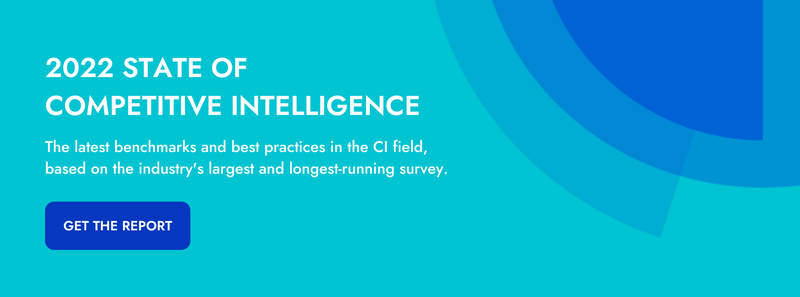There’s a lot of things I should do. I should stretch in the morning. I should go to the dentist every six months. I should stay off Twitter for the rest of my life.
But just because I should do something, doesn’t mean I’m going to.
I’m not alone in this respect. You have colleagues, for example, who should regularly use the competitive insights and content you deliver to them. But if your competitive intelligence program is like most, adoption probably isn’t where you want it to be.
That’s why we sat down with Gainsight’s Darrin Helsel, Affinity’s Carolyn Klinger, and Apprize360’s Tim Rhodes—to find out what they’re doing to maximize the impact of their efforts.
You can watch the conversation, as part of our Competitive Intelligence Live series, in its entirety here. But if you’ve only got a few minutes, this blog post is going to recap six of the best tips that came out of it:
- Get aligned with your company’s overarching priorities
- Make friends at all levels of the organization
- Use quick wins to earn trust
- Bring people together
- Use rewards to build momentum
- Be realistic about your bandwidth
Let’s get started.
1. Get aligned with your company’s overarching priorities
A little information about the competition can go a long way. You can use it to help sellers win, to help marketers execute, to help product managers prioritize—the list goes on.
But if what you’re doing with CI is out of sync with what your company, as a whole, is trying to accomplish, very few people are going to use the content you produce—regardless of how skilled you are as a researcher, or an analyst, or a storyteller.
“You may have preconceived notions [of what’s important], but it’s about balancing the priorities that you bring into the organization with the priorities of the organization itself,” says Darrin. “You have to understand those priorities across your stakeholder groups—especially your leaders—so you can build the program that’s best for them.”
2. Make friends at all levels of the organization
Determining what your company, as a whole, is trying to accomplish—that’s a bit of a daunting task. But the good news is that there’s an extraordinarily simple way to go about it:
You have to talk to people.
More specifically, you have to talk to all kinds of people, from your CRO to your newest BDR. Not only will this help you get the alignment that Darrin has found to be so crucial, but it will also kick start some momentum for your program—in more ways than one.
“If you can get buy-in from leadership and then work from the bottom-up [by building relationships with your account executives and BDRs],” says Carolyn, “you’ll create this 360-degree push of support around the initiatives that you’re working on.”
3. Use quick wins to earn trust
To make friends, you have to earn trust—and to earn trust, you have to make it clear that you know what you’re doing.
“Whenever I enter a new organization,” says Tim, “I ask: What’s the big competitive issue that’s causing frustration for the sales team? And then I try to solve that first, because that demonstrates that I’m going to add value, and that helps me earn trust.”
4. Bring people together
As the designated leader of your competitive intelligence program, you may feel pressure to have all the answers all the time—but that’s not necessary. If you assemble your colleagues on a regular basis to talk through the competitive questions on their minds, they’ll often find that they can help each other, relieving you of that pressure to be the smartest person in the room.
“At a previous company, we had these weekly drop-in sessions, primarily for our sales and customer success teams,” says Tim. “For the first 5-10 minutes, I would share the latest and greatest intel, and then we’d open up the floor to the reps to talk about their competitive deals. As these sessions got more popular and the reps got more comfortable, they started to help each other by talking about similar experiences that they’d had in the past—both wins and losses.”
5. Use rewards to build momentum
When you’re trying to grow adoption of your competitive content, what you’re really doing is trying to get people to form new habits. And as we all know from our personal lives, the key to getting someone to form a new habit—whether that someone is a pet, or a kid, or yourself—is a reward.
“With Crayon, we’re able to track battlecard usage and competitive win rate, and we’re using these two metrics to create a quarterly competitive intelligence award,” says Darrin. “The person who uses our battlecards the most and has the most success with those battlecards will be given a reward that they can enjoy outside of work. The goal is to ingrain CI deeper in our sellers’ thinking and to add value to our go-to-market strategy.”
6. Be realistic about your bandwidth
Like we said earlier: With the role of competitive intelligence leader comes a feeling of pressure to have all the answers all the time. One solution is to help your colleagues help each other, and another solution is to let go of perfection.
Obviously, the content you ship needs to meet some standard of quality. But if your pursuit of perfection is keeping you from sharing the information that your colleagues need right now, then unfortunately, you’re doing more harm than good.
“I’m a team of one with a lot of responsibilities, and in the past few months, I’ve only been able to ship two battlecards—and I felt bad about it,” says Carolyn. “So what I decided to do is publish some battlecards using Crayon’s automated insights, and over time, I’ll add my messaging and positioning and analysis. It’s not ideal, but after speaking with some folks in sales enablement, I realized that it’s better to ship something—even if it’s not perfect at first—than to ship nothing.”
You’ve got what it takes
For more insight into the process of growing competitive intelligence adoption, watch the full conversation with Darrin, Carolyn, and Tim. And when you’re done, dive deeper into the topics of alignment, culture, and technology with these blog posts:

Related Blog Posts
Popular Posts
-
 How to Create a Competitive Matrix (Step-by-Step Guide With Examples + Free Templates)
How to Create a Competitive Matrix (Step-by-Step Guide With Examples + Free Templates)
-
 The 8 Free Market Research Tools and Resources You Need to Know
The 8 Free Market Research Tools and Resources You Need to Know
-
 Sales Battlecards 101: How to Help Your Sellers Leave the Competition In the Dust
Sales Battlecards 101: How to Help Your Sellers Leave the Competition In the Dust
-
 6 Competitive Advantage Examples From the Real World
6 Competitive Advantage Examples From the Real World
-
 How to Measure Product Launch Success: 12 KPIs You Should Be Tracking
How to Measure Product Launch Success: 12 KPIs You Should Be Tracking





